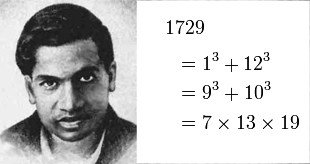Srinivasa Ramanujan was a self-taught mathematician from India. Born on December 22nd 1887 in the small village of Erode, near Madras. Ramanujan quickly developed an exceptional understanding of maths, impressing both his teachers and classmates. When he was 15, he discovered a book called A Synopsis of Elementary Results in Pure Mathematics, which contained 4400 mathematical results but no proofs. Ramanujan spent the next few years confirming every single one, eventually moving on to prove his own ideas.
Many of his proofs were not new, as Western mathematicians had discovered them hundreds of years before, but unconstrained by traditional teaching Ramanujan came up with his own brand of mathematics. He believed his ideas were visions from the Hindu goddess Namagiri, once saying, ‘An equation for me has no meaning unless it expresses a thought of God’.
Ramanujan’s devotion to maths meant he had little time for other subjects, and failed his college exams in English and physiology. This meant he couldn’t attend the University of Madras, and got a job as an office clerk instead. He continued his passionate study of maths, publishing papers in Indian mathematical journals, and eventually contacting mathematicians in England. Two failed to decipher his unconventional style, but G. H. Hardy recognised his brilliance and arranged for him to visit Cambridge University.
The pair collaborated for a number of years, with Hardy’s rigorous approach complementing Ramanujan’s wild ideas. Despite their success Ramanujan found adjusting to life in England very difficult and was often ill. He returned to India in 1919 and died soon after at the young age of 32. Nevertheless, many mathematicians consider Ramanujan one of the greatest mathematicians of the 20th century, and today still pore over his notebooks, hoping to unlock their mathematical secrets.






